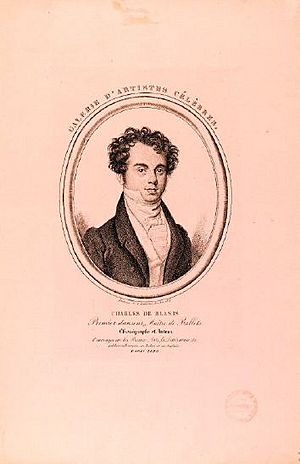Carlo Blasis facts for kids
Carlo Blasis (born November 4, 1797 – died January 15, 1878) was a very important Italian dancer, choreographer, and dance expert. He was born in Naples. Blasis is famous for his strict dance classes, which sometimes lasted four hours! He believed students should not only dance but also learn the ideas and rules behind each step. Many teachers of the well-known ballet master Enrico Cecchetti were trained by Blasis. People think Blasis's teaching style helped Cecchetti create his own famous ballet method.
Contents
Carlo Blasis: A Dance Master
His Important Writings
Carlo Blasis wrote a lot about dance. In 1820, he published a book called Traité élémentaire, théorique, et pratique de l'art de la danse. This means "Elementary, Theoretical, and Practical Book on the Art of Dance." In this book, he shared his ideas about ballet techniques. He is most famous for creating the "Attitude" pose in ballet. This pose was inspired by a famous statue of Mercury made by Giovanni da Bologna. Enrico Cecchetti later built upon Blasis's teaching methods and theories.
Even when Blasis was alive, he was not best known for the dances he created. Sadly, none of his choreographies (the dances he made) still exist today. Instead, he was known for his writings about dance theory. He was one of the first to connect the graceful and light movements of ballet with the science of how bodies move.
In his 1828 book, The Code of Terpsichore, Blasis created a clear "alphabet" of dance poses. This was a big step! It might have been the very first time someone tried to organize and explain dance in such a complete way.
New Ideas for Dance
Blasis changed how people thought about dance theory. He used a lot of math and physics in his ideas. He came up with the idea of a "movement axis." Imagine a straight line going up and down through a dancer's body. This line shows the center of balance. It helps dancers understand how to stay steady while moving.
Blasis also had new ideas for how to teach dance. He suggested that teachers should first describe the dance poses from his books. Then, students should memorize these poses before trying to do them physically. He even said that the most hardworking students could draw copies of the poses on small slates. They could then take these home to study, just like a child learning to read studies their ABCs.
Blasis believed that by using the poses in his "alphabet," dancers could achieve the qualities ballet wanted. These qualities included moving easily and elegantly. In his book Notes Upon Dancing, Historical and Practical, Blasis praised some ballets for showing strong feelings. For example, he wrote about "The Neapolitan Tarantella." He said that "love and pleasure are clear in every movement." So, Blasis wanted dancers to add deep feelings to the organized poses that choreography required.
Teaching the Next Generation
Through his methods, Blasis wanted to guide the new Romantic ballet style. He wanted it to follow classical rules. In this way, Blasis was ahead of his time. He was especially interested in movements that were considered too difficult for the early 1800s. For example, he started to break down the pirouette (a ballet turn) into steps. He explained it as a preparation, a turn, and a finish.
It wasn't until the time of Marius Petipa in the late 1800s that hard steps like the pirouette became common in ballet. Yet, Blasis was studying and explaining them decades before.
From 1838 to 1853, Blasis was the Artistic Director of what is now the La Scala Theatre Ballet School. Many famous ballerinas were his students. These included Fanny Cerrito, Carolina Rosati, Sofia Fuoco, Amalia Ferraris, and Carlotta Brianza.
Blasis passed away in Cernobbio.
See also
 In Spanish: Carlo Blasis para niños
In Spanish: Carlo Blasis para niños


